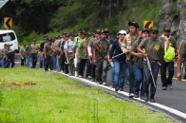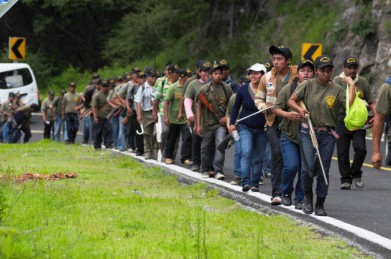
The backdrop of the whole situation, declares the former Naa Savi coordinator, includes mining projects and companies who want to enter the area. “If we allow the army to enter communal territory, they will never leave. The government has its eye on exploiting the mines, they want us to fight amongst ourselves, so that they can come in and militarize the territory. That’s the bottom line here.” Carrasco believes it’s false that the government is fighting organized crime because “they are fighting the Indigenous people, that’s their goal.”
 This article, originally published online by Mexico City-based Desinformémonos, provides insight into the process taking place within and among community policing groups in Guerrero in a context of increasing repression. Nestora Salgado García’s husband, José Luis Ávila Baez, is currently on hunger strike in front of the United Nations building in New York City, where he along with allies and family members have been protesting her detention.
This article, originally published online by Mexico City-based Desinformémonos, provides insight into the process taking place within and among community policing groups in Guerrero in a context of increasing repression. Nestora Salgado García’s husband, José Luis Ávila Baez, is currently on hunger strike in front of the United Nations building in New York City, where he along with allies and family members have been protesting her detention.
Source: Desinformémonos
GUERRERO-The sights are on the mines. For this reason Guerrero is being militarized, foodstuffs are being handed out, community police are being arrested on charges of links with guerrillas, state founded rural police forces are being formed, and community leaders are being bought or jailed.
The Regional Coordinator of Communal Authorities – Community Police (CRAC -PC), the organization exercising security, justice and rehabilitation with the most years in the mountains of Guerrero, is once again being harassed by elements of the Mexican army. In Olinalá on August 21, Nestora Salgado García – one of the principal authorities of the indigenous peoples in the area – and several members of the CRAC-PC of the House of Justice* in the town of El Paraíso, were arrested.
It is reported that army convoys have entered several areas in the La Montaña and Costa Chica regions. In the municipality of Ayutla de los Libres, the Houses of Justice in the towns of El Paraiso, and Quihuatepec have been raided. Hundreds of soldiers released several detainees held by the CRAC-PC and detained members of the community police. In Olinalá, soldiers are on the hunt, following the paths of members of the Community Police.
The Collective Against Torture and Impunity (CCTI ), the Regional Centre for the Defense of Human Rights “Jose Maria Morelos y Pavon” and the Democratic Front of Organizations of the State of Guerrero share a common analysis on what is occurring in Guerrero. In a document calling for urgent action, they declared “the current events are occurring in the context of increased militarization in the regions of La Montaña and the Costa Chica of Guerrero. Authorities justify these actions by the military as part of the installations that are being set-up for the Crusade Against Hunger* in the region.”
In an interview with Desnformémonos, Vidulfo Rosales, lawyer of the Tlachinollan Human Rights Center declared that the federal government and the military have a counterinsurgency vision: “They want to give a military solution to social problems that the state itself created and is unable to solve.” It is paradoxical that in Guerrero “fellow comrades of the Community Police face federal charges, while organized crime walks freely through the streets of Chilpancingo and Acapulco and appear dead at all hours.”
Rosales continued that the federal government has the wrong analysis because “they believe the community police may be involved with guerilla or subversive groups,” which, he said, is not true. The Community Police is a result “of the State’s failure to carry out the tasks of security and justice, of preventing kidnappings and extortion, a situation which extends to indigenous communities. Thus, security of these communities is being exercised by the people themselves,” stated the human rights defender.
Community members going to prison
Nestora Salgado, the main leader of the Citizens Police in Olinalá, took leadership of security in October 2012, expelling hitmen from her community. Now she is being charged with kidnapping, and was sent to a maximum-security prison in Nayarit because, in the opinion of the authorities, she is a highly dangerous person.
Salgado was arrested by elements of the Mexican army and navy, who produced no warrant. Immediately, members of the CRAC-PC from the House of Justice in El Paraiso set up roadblocks to block the Federal Chilpancingo-Tlapa highway, near Tixtla, which connects the High Mountain with Chilpancingo.
The Mexican army, in an act of persecution against the Indigenous organization, raided the offices of the House of Justice in El Paraíso. The CCTI informed that, according to information provided by Arturo Campos, regional coordinator of the House of Justice, “at 10 pm 30 vehicles arrived with elements of the Mexican army, who raided the premises and beat about 40 members of the Community Police.”
In an interview with Desinformémonos, Claudio Carrasco, former coordinator of the CRAC-PC and now part of the House of Justice in El Paraiso, notes that “perhaps it is that the government is only paying attention to the newspapers of Guerrero, in which one of the [former] coordinators days before rejected recognition of the House of Justice in El Paraiso, and began a persecution campaign against members of the organization in the area.”
The Mexican army, “rejected recognition of the organization’s practice of community justice and autonomy, and took the 39 detainees who were undergoing rehabilitation at the House of Justice,” said Carrasco.
Carrasco, who practiced law in La Montaña, reports, “we want them to be return to be rehabilitated. We apply another form of justice and we want to be left alone to do it. We are not against anyone.”
According to Carrasco, who is also the former coordinator of the House of Justice in the community of Espino Blanco, community members view the actions of public authorities as not being valid. “The State Government doesn’t represent us, nor a single house of justice,” he said. It needs to be underscored that in 1995 the organization was created by the native peoples and “not by the government…We were created legally and legitimately because of the injustice that existed in La Montaña and Costa Chica.” The community member says that “the government does not have to get involve in the affairs of the organization, we just want peace and tranquility for our people and communities.”
All detainees, says a letter written by human rights organizations, “belong to an organization of Indigenous peoples and communities that are protected under State Law 701 on the Recognition, Rights and Culture of Indigenous Peoples and Communities of the State of Guerrero (in which Indigenous rights related to justice are clearly stipulated, permitting the execution of activities for the prevention, justice and rehabilitation of transgressors); Convention 169 of the International Labor Organization (ILO); the UN’s Declaration on Indigenous Peoples, and Article 2 of the Mexican Constitution.”
Once again, mining
The backdrop of the whole situation, declares the former Naa Savi coordinator, includes mining projects and companies who want to enter the area. “If we allow the army to enter communal territory, they will never leave. The government has its eye on exploiting the mines, they want us to fight amongst ourselves, so that they can come in and militarize the territory. That’s the bottom line here.” Carrasco believes it’s false that the government is fighting organized crime because “they are fighting the Indigenous people, that’s their goal.”
Meanwhile, in separate interviews in the newspaper El Sur de Acapulco, Elisha Villar, one of the four coordinators of the House of Justice in San Luis Acatlán, which now doesn’t recognize the House of Justice in El Paraiso, and Bruno Placido – leader of the Union of Communities and Organizations in the State of Guerrero (UPOEG) – agreed not to support the actions of the Houses of Justice of El Paraiso and Espino Blanco (who publicly supported those who were attacked). Both have negotiated agreements with the state government, thus receiving 2 million pesos.
For their part, the Houses of Justice in Espino Blanco, San Luis Acatlán and Zitlaltepec have demanded the release of detainees and convened, through an internal newsletter, an emergency meeting and a regional meeting on August 31. “We call on all peoples and communities who are members of the CRAC-PC, all community police groups, all municipal commissioners and agricultural authorities, to be present at the next regional meeting which will be of vital importance to the organizational process that will be followed by our communal system,” said the internal newsletter.
They noted that it is a scenario that they had never imagined: “Some differences have emerged with some of the leaders of the CRAC-PC in the different regions, but not with the people and communities or their local authorities. In accordance with community and regional authorities of the three Houses of Justice, signatories of this statement, we require state and federal governments to fully respect our community organization, community authorities, as well as our community policing groups. Internal deficiencies will be addressed immediately in the next regional assembly that has been scheduled.”
Mining is the target of business and government interests in La Montaña, according to Vidulfo Rosales, but it is also about controlling social organizations: “the organizational processes against mining and the Biosphere Reserve form part of the social discontent against poverty and marginalization in which communities find themselves. [Authorities] envision a front of Guerrero social organizations protesting, and which they cannot control, so their strategy is to militarize the area.” The human rights defender asked: “What is the role of the Mexican State? To create peace or contain social discontent and social organizational processes?”
